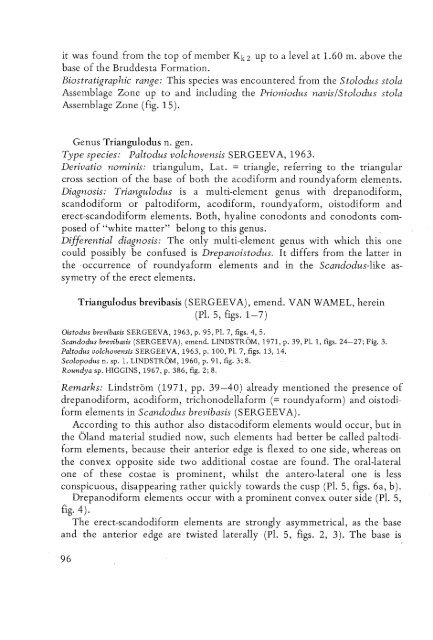UTRECHT MICROPALEONTOLOGICAL BUllETINS
UTRECHT MICROPALEONTOLOGICAL BUllETINS
UTRECHT MICROPALEONTOLOGICAL BUllETINS
You also want an ePaper? Increase the reach of your titles
YUMPU automatically turns print PDFs into web optimized ePapers that Google loves.
it was found from the top of member K k2 up to a level at 1.60 m. above the<br />
base of the Bruddesta Formation.<br />
Biostratigraphic range: This species was encountered from the Stolodus stoIa<br />
Assemblage Zone up to and including the Prioniodus navislStolodus stoIa<br />
Assemblage Zone (fig. 15).<br />
Genus Triangulodus n. gen.<br />
Type species: Paltodus volchovensis SERGEEV A, 1963.<br />
Derivatio nominis: triangulum, Lat. = triangle, referring to the triangular<br />
cross section of the base of both the acodiform and roundyaform elements.<br />
Diagnosis: Triangulodus is a multi-element genus with drepanodifo~m,<br />
scandodiform or paltodiform, acodiform, roundyaform, oistodiform and<br />
erect-scandodiform elements. Both, hyaline conodonts and conodonts composed<br />
of "white matter" belong to this genus.<br />
Differential diagnosis: The only multi-element genus with which this one<br />
could possibly be confused is Drepanoistodus. It differs from the latter in<br />
the occurrence of roundyaform elements and in the Scandodus-like assymetry<br />
of the erect elements.<br />
Triangulodus brevibasis (SERGEEVA), emend. VAN WAMEL, herein<br />
(PI. 5, figs. 1-7)<br />
Oistodus brevibasis SERGEEVA, 1963, p. 95, PI. 7, figs. 4, 5.<br />
Scandodus brevibasis (SERGEEVA), emend. LINDSTROM, 1971, p. 39, PI. 1, figs. 24-27; Fig. 3.<br />
Paltodus volchovensis SERGEEVA, 1963, p. 100, Pi. 7, figs. 13, 14.<br />
Scolopodus n. sp. 1. LINDSTROM, 1960, p. 91, fig. 3; 8.<br />
Roundya sp. HIGGINS, 1967, p. 386, fig. 2; 8.<br />
Remarks: Lindstrom (1971, pp. 39-40) already mentioned the presence of<br />
drepanodiform, acodiform, trichonodellaform (= roundyaform) and oistodiform<br />
elements in Scandodus brevibasis (SERGEEVA).<br />
According to this author also distacodiform elements would occur, but in<br />
the bland material studied now, such elements had better be called paltodiform<br />
elements, because their anterior edge is flexed to one side, whereas on<br />
the convex opposit~ side two additional costae are found. The oral-lateral<br />
one of these costae is prominent, whilst the antero-lateral one is less<br />
conspicuous, disappearing rather quickly towards the cusp (PI. 5, figs. 6a, b).<br />
Drepanodiform elements occur with a prominent convex outer side (PI. 5,<br />
fig. 4).<br />
The erect-scandodiform elements are strongly asymmetrical, as the base<br />
and the anterior edge are twisted laterally (PI. 5, figs. 2, 3). The base is
















